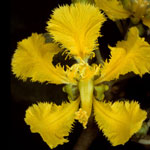Morphological and molecular evidence, accumulated since Niedenzu’s publication of a family monograph in 1928, indicates that the traditional system used by him and his predecessors is unsatisfactory, but we do not yet have a fully resolved phylogeny that will permit the recognition of a new set of subfamilies and tribes. As an interim measure the genera will be grouped here informally in the clades that have received at least moderate support in the recently published phylogenetic trees based on DNA sequences (Cameron et al. 2001 [pdf]; Davis et al. 2001 [pdf]; Davis et al. 2002 [pdf]; Davis & Anderson 2010 [pdf]) and subequent phylogenetic trees based on both sequences and morphology (C. C. Davis & W. R. Anderson, unpublished). These groupings are subject to change as our understanding of the family's phylogeny improves. — For a recent interpretation of the Galphimia clade, see Davis et al. (2020a); of the Tetrapterys clades, see Almeida & van den Berg (2021).
The clades presently recognized are listed below in alphabetical order. Treatments of clades and their component genera will be added as they become available.
Clades currently recognized
Niedenzuella clade
Tetrapterys clades
